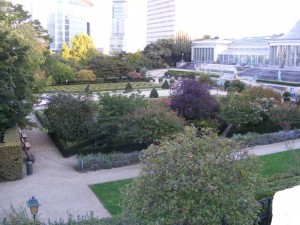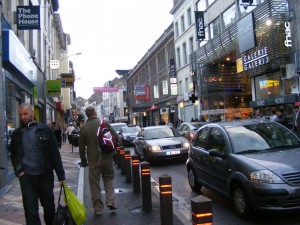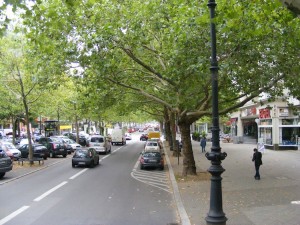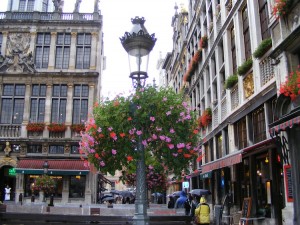Today’s post is a continuation of my series Learning from European Cities and I’d like to talk about the role of green space in urban life. In my past visits to European and South American cities, I’ve always been impressed by the green space embedded in their urban fabric in the form of beautiful, lush city parks. On my recent trip to Europe, I was particularly impressed with the green spaces in Brussels. This may partially be due to the fact that Paul and I stayed next to the Botanique, a beautiful and very old botanical garden right in the middle of the city.
The Botanique (botanical gardens) in Brussels established in 1829
In dense cities, it’s very hard to incorporate nature into the every day experience of the city dweller:
A busy street in the heart of Brussels
It is usually crowded, cramped, always in motion and you’re surrounded by a man-made world of the street, buildings and cars. This is why it’s so important that dense cities have places of respite from the harsh pulse of the city. Besides the obvious psychological benefits, a connection with nature has been shown to have health benefits as well and it’s even been proven to aid in healing. According to Rachel and Stephen Kaplan in their book The Experience of Nature: A Pscychological Perspective, “People with access to nearby natural settings have been found to be healthier overall than other individuals. The longer-term, indirect impacts (of ‘nearby nature’) also include increased levels of satisfaction with one’s home, one’s job and with life in general’. No wonder city dwellers in Europe like to escape to the country every now and then.
In Brussels, there were some very beautiful and relatively large parks embedded in city. In many instances, these parks are older than many of the buildings that surround them, but the people and government of Brussels made sure that these green spaces remained intact as the city grew around them. And now they reap the benefits of these gorgeous parks that provide much needed peace and quite amidst the hustle and bustle of city life.
A meditation garden within the Botanique
Besides full-blown parks, there are other ways to insert the serene influence of nature into busy cities. One is the presence of the urban forest, which comprises mostly of the trees and other plants around the city, but is not limited to those things. I noticed in the European cities I visited, there were very few trees in the heart of the cities, but there was a significant canopy of trees just outside of the very center. Unlike our young scrawny trees in Phoenix, almost all the trees I saw in Europe were old, lush, very established and quite breathtaking. Even though these trees are not in a natural setting but a part of the urban environment they still provide the psychological and physical benefits of nature to city dwellers.
The lovely canopy of trees a little bit outside the center of Berlin
Another rather delightful way that nature is inserted into European cities is in the form of flower boxes and baskets adorning the balconies of apartment buildings and street lights:
Pleasingly, flower arrangements made an appearance all over Brussels
Although these small bursts of plants may seem insignificant in the middle of an imposing urban landscape, they go a long way in terms of reminding people about the sheer beauty and power of nature.
I think in regards to a connection with nature, we are way ahead of many European cities here in Phoenix. Because we aren’t a very dense city and because of our unique landscape, we have lots of opportunities to experience nature in our daily lives with readily available views of the mountains, a wide open blue sky and some of the most beautiful sunsets in the world. And Phoenicians are able to escape the city and immerse themselves in a natural environment with just a short ride to a mountain preserve. Plus, in addition to visiting city and state parks around town, which are woefully underutilized, we can walk or ride our bikes on the canals.
That being said, we still have a unique opportunity to build an even stronger and more meaningful connection with nature and that is by utilizing some of the empty lots that plague our city and turning them into green spaces. I’ve been told by various people ranging from city councilmen to local business people about all the reasons we aren’t able to make anything useful out of these empty lots. And I’ve heard from some that it’s useless to even dream that anything could possibly be done with these empty lots.
I don’t believe it’s useless to dream of and to plan for a better future for our city. Some really fantastic uses for many of our empty lots would be to turn them into urban gardens, city parks, or green public squares. For a great example of making a (newly) empty lot into a green space, read about Sean Sweat’s proposal for a dog park at the site of the Sahara Hotel in answer to the currently proposed black space – a 2 acre parking lot.
Photo Credit: All photos by the author.


























Great article, Phoenix and Scottsdale have some very nice open spaces. Papago Park and the New Rio Salado project are a few that I use, no-one is ever at the Rio Salado, and I guess it is because some of these nice spaces are not accessable on a moments notice, you have to actually make them a destination. South Mountain and Squaw Peak are two more……alas I think the heat and lack of plants has something to do with it. They all seem to be like everything else in Phoenix….get in the car and drive to the parking lot and then enjoy……don’t know how to change how we grew up…..but mabe as we mature things will change…..
Wayne, you’re right about the fact that we have to drive to our green spaces and that takes away some of the benefits. But then again we drive to almost every destination for the most part, so until we fix that issue, we’re going to have to keep driving to our green spaces. Steele Indian School park is one park that I mostly ride my bike to, and that is nice. It’s location in the center of the city is very convenient, same goes for Encanto, although that is not really in my neighborhood. The best parks are neighborhood parks you can walk to, but alas things are so far apart here and there aren’t many neighborhood parks near enough to walk!
I wasn’t as impressed with the green spaces in Brussels as you were. I saw more cobblestone and paved squares there. The Botanique area is a unique area like New York’s Central Park. The window boxes in Brussels are a spectacular addition that every business, apartment, or home seemed to add to the aesthetics of the city. But I do agree with your overall thesis that Phoenix needs more green spaces in the center city. Downtown is a heat island with so much concrete and asphalt that make livability, and strolling in the city center less desirable. No wonder people don’t hang out downtown. It’s not pretty. It’s not inviting. If you want to see livable in terms of green space design, go to Savannah. That’s heaven. But we’ll never be Savannah with a tree canopy because we don’t have a lot of deciduous trees that are drought tolerant in Arizona. However, we could make the city greener with more center city pocket parks, grass, flowers, fountains, palms and native trees. But everyone has to have that as part of their vision, and residents have to be willing plant and or pay for upkeep and maintenance for those spaces as part of the cost of living in an oasis in the desert. Trees grow faster here and blow over; water cost more here; flowers require year round care. The greener grass lifestyle we envision cost more in Phoenix, but it would pay for itself if we got more people to live, work, stay and play downtown.
Wally, good point about the residents of Phoenix getting on board and paying extra (in taxes) for these green space amenities. But we live in a highly tax-phobic state and city and it seems like a long shot. The Civic Space Park is a nice addition to Downtown, although for some reason it’s still not quite there yet in terms of really attracting people who work and live in the city besides students.
I feel that the City of Phoenix does an excellent, if not World Class job with our Mountain and Desert preserves. We have former Mayor Hance to thank for that.
On the other hand, we do about as bad a job as possible with our traditional parks. Most of them have yellow dead grass for months on end (during the months when its nice to be outside in a park!) are poorly planned, devoid of enough trees, oddly (or not at all) programmed, etc. Furthermore there’s little to no connection between most parks and their surrounding areas.
The Canalscape idea is great and I hope it happens, it along with the Mountain Preserves could be the backbone of a “Turquoise Necklace” connecting our major parks.
Encanto Park needs some serious TLC and probably expansion. Hance is a joke and the Cities plans for it are embarrassing, Steele Indian School is nice but set back and away from everything.
We lost our Cities Central Square (Patriots Square) and while it was awful, what it was replaced with wasn’t a square or park, and was lame as well. Like I said over on Facebook, we need to demand that RED & the City turn the lot bounded by Wash./Jeff. & 1st/2nd is turned into a new Central Square that Downtown desperately needs.
Will I think you hit the nail on the head with our traditional parks. They are poorly maintained, not very well shaded and aren’t connected with the rest of the city. Indian Steele School Park, though very nice inside, is surrounded by a wall. Imagine if it were wide open and porous, what a great effect it would have on it’s surroundings and how much more people would use it. I don’t get the wall, why the heck is that wall there? It kills the potential of that park!
The wall is a big issue, but so is the fact that the N.E. corner of Central and Indian School is a huge dirt lot. And so is the NW corner now, as is another lot on the West side of Central just a bit North of Indian School Rd.
The “outer park” area is just a moonscape, so its no wonder the park is underused. There’s no one living, working, playing, shopping or doing anything adjacent to the park.
It really is a nice park though, one would think it would’ve spurred some development near it, but sadly it hasn’t.
I blame the wall Will! Maybe if the wall were gone, more people would use it, the moonscape might be developed into something nicer and it would be a great spiral upwards for the area…
I wondered as I rode along the Grand Canal just north of Steele Indian School why the canal and park are not obviously connected. It seemed like an excellent canalscape opportunity utterly missed. In fact, the entire north end of the park looks like an exercise in urban planning futility. Parks need people, people need parks. Can’t get in that way, though.
good point John, I never thought about this node of where the canal meets the park. What a perfect connection it would make, and it would be yet another way to get more people to the park, making it a destination reachable by canal. Hmmm, this might be an idea to propose to the Parks Department at some point.
Love this idea, Tazmine! There are numerous single, unusually large parcels in West Mesa that are sorely underutilized. Many of them also happen to be located within neighborhoods where children live in multi-unit rental complexes and have no place to play but in the street. It’s a perfect fit.
I have a neighbor here Mesa, who is US born but grew up in Mexico. Something that he brought with him is an old-fashioned sensibility about how valuable rainfall is. He has installed a cistern under one of his uncovered patios.
The patio provides a smooth surface that channels sheets of rainwater into an underground tank. From this tank, he can pump water around his property in conventional irrigation piping.
I have discovered that this concept also belongs to the modern Permaculture movement, but could possibly provide beautiful potential for a sustainable neighborhood park in the Sonoran Desert(?). I am just thinking of a way to provide a natural play environment for children who may have otherwise spent their childhood exploring amongst cars, sidewalks, and stucco walls.
I wonder if there is funding available for something like this?
Dan, I love the idea of rainwater harvesting for a public park. It makes so much sense along with using drought-tolerant native vegetation. I think there probably is funding for something like this if you look in the right places. Really great idea.
[…] robust comments section, ahem), and was particularly taken with yesterday’s piece, “Craving Green Breathing Space in a Fast-Paced City.” The gist of it is pretty straightforward, and it’s something that we talk a lot about […]
As you may or may not know, I am passionate about this issue, both from an aesthetic and environmental perspective. If Phoenix is to survive, it’s imperative that we address the heat island effect exacerbated by the lack of green in any form. It’s been especially noticable since the decimation of agriculture in South Phoenix and the East Valley during the construction boom. The heat emanating from relentless concrete during the summer months impacts the monsoon storms that now rarely occur in the central city.
Taz, this might be a good time to mention the tree/shade meeting on March 9 at the AE England Building. Don’t know if there are any slots left for attendees. i’m looking forward to it.
Diane, thanks for your comment. You’re right, green space, or the lack thereof, has such a profound and wide impact on our city and our daily lives. Here’s a link to the Tree and Shade Summit…http://www.facebook.com/home.php#!/event.php?eid=188063431226638